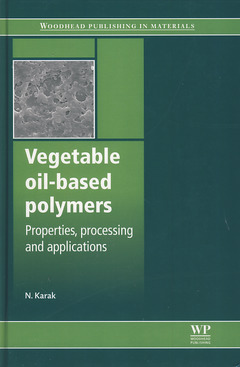Vegetable Oil-Based Polymers Properties, Processing and Applications
Auteur : Karak Niranjan

After an introduction to classification and polymerization, Vegetable oil-based polymers goes on to review the factors involved in polymer biodegradation. The extraction, purification and application of vegetable oils are then explored, along with vegetable oil-based polyesters and poly(ester amide)s, polyurethanes and epoxies. The book then reviews polyamides, polyolefins and vegetable oil-based hyperbranched polymers. It concludes with an analysis of vegetable oil-based polymer composites and polymer nanocomposites.
Vegetable oil-based polymers is an indispensable guide for all those involved in the research and development of biopolymers as well as the wide range of industries looking for more sustainable polymer materials.
Author contact details
List of abbreviations and symbols
Dedication
Preface
Acknowlegement
Chapter 1: Fundamentals of polymers
Abstract:
1.1 Introduction
1.2 Classification
1.3 Raw materials for polymers
1.4 Polymerisation process
1.5 Polymerisation techniques
1.6 Modifications
1.7 Characterisation
1.8 Structure and properties
1.9 Additives and processing
1.10 Applications
1.11 Future Challenges for polymers
1.12 Revision questions
Chapter 2: Biodegradable polymers
Abstract:
2.1 Introduction
2.2 Definition of biodegradable polymers
2.3 Background
2.4 Classification
2.5 Factors affecting biodegradation
2.6 Approaches to biodegradable polymers
2.7 Biopolymers
2.8 Mechanisms of biodegradation
2.9 Biodegradation testing methods
2.10 Applications
2.11 Current status and future trends
2.12 Revision questions
Chapter 3: Vegetable oils and their derivatives
Abstract:
3.1 Introduction
3.2 Classification
3.3 Extraction
3.4 Purification
3.5 Storage
3.6 Characterisation
3.7 Structure and properties
3.8 Vegetable oils used in industry and research and development
3.9 Industrial oleochemicals
3.10 Applications
3.11 Revision questions
Chapter 4: Vegetable oil-based polyesters
Abstract:
4.1 Introduction
4.2 Classification
4.3 Raw materials
4.4 Preparation or resinification
4.5 Modification
4.6 Characterisation
4.7 Structure and properties
4.8 Applications
4.9 Revision questions
Chapter 5: Vegetable oil-based poly(ester amide)s
Abstract:
5.1 Introduction
5.2 Materials and methods
5.3 Preparation or resinification
5.4 Modification
5.5 Curing
5.6 Characterisation
5.7 Structure and properties
5.8 Applications
5.9 Revision questions
Chapter 6: Vegetable oil-based polyurethanes
Abstract:
6.1 Introduction
6.2 Classification
6.3 Materials and methods
6.4 Preparation techniques
6.5 Modification
6.6 Characterisation
6.7 Structure and properties
6.8 Applications
6.9 Revision questions
Chapter 7: Vegetable oil-based epoxies
Abstract:
7.1 Introduction
7.2 Classification
7.3 Materials and methods
7.4 Modifications
7.5 Curing
7.6 Characterisation
7.7 Structure and properties
7.8 Applications
7.9 Revision questions
Chapter 8: Polyamides, polyolefins and other vegetable oil-based polymers
Abstract:
8.1 Introduction
8.2 Materials and methods
8.3 Engineering polymers
8.4 Addition polymers
8.5 Structure and properties
8.6 Applications
8.7 Revision questions
Chapter 9: Vegetable oil-based hyperbranched polymers
Abstract:
9.1 Introduction
9.2 Comparison with conventional polymers
9.3 Preparative methodology
9.4 Modification
9.5 Characterisation
9.6 Structure and properties
9.7 Applications
9.8 Future trends and challenges
9.9 Revision questions
Chapter 10: Vegetable oil-based polymer composites
Abstract:
10.1 Introduction
10.2 Classification
10.3 Materials and methods
10.4 Testing and analysis
10.5 Performance of composites
10.6 Varieties of vegetable oil-based polymer composites
10.7 Applications
10.8 Concluding remarks
10.9 Revision questions
Chapter 11: Vegetable oil-based polymer nanocomposites
Abstract:
11.1 Introduction
11.2 Significance
11.3 Classification
11.4 Comparison with conventional polymer composites
11.5 Nanomaterials
11.6 Preparative methodologies
11.7 Characterisation
11.8 Properties
11.9 Varieties of vegetable oil-based polymer nanocomposites
11.10 Applications
11.11 Concluding remarks
11.12 Revision questions
Index
- Provides a comprehensive review of recent research in the area of vegetable oil-based polymeric materials
- Discusses vegetable oils and their derivatives, biodegradable polymers and the fundamentals of polymers
- Explores the extraction, purification and application of vegetable oils, along with vegetable oil-based polyesters and poly(ester amide)s, polyurethanes and epoxies
Date de parution : 07-2012
Ouvrage de 336 p.
15.5x23.2 cm



